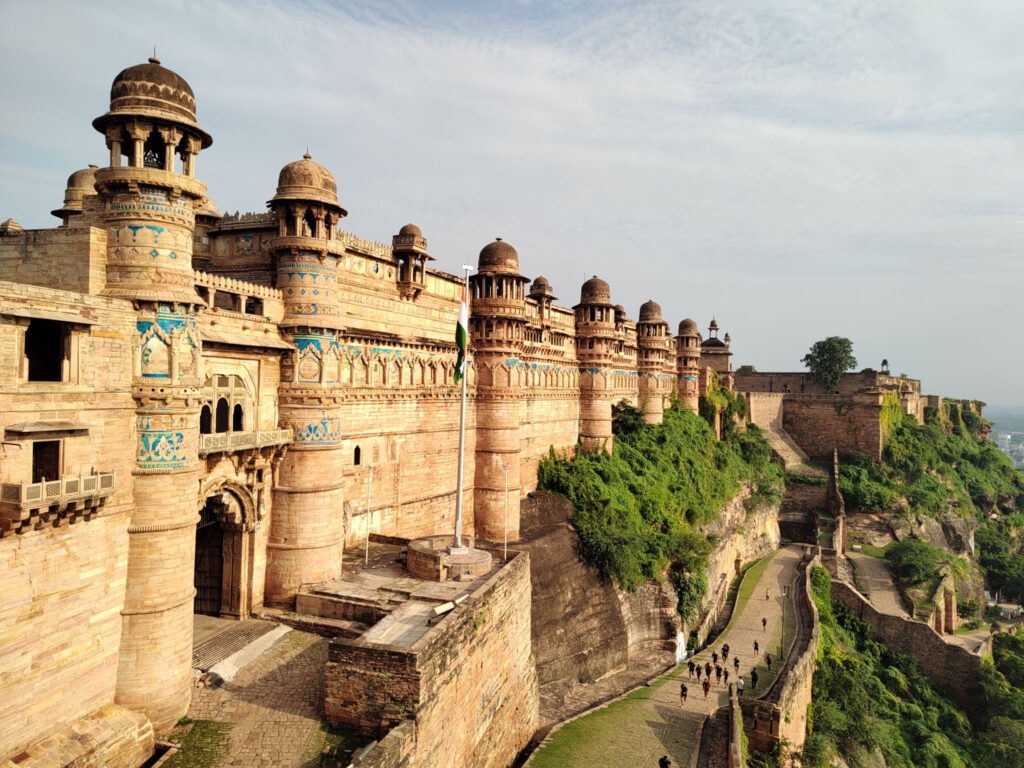
Credit: SHUBHAM KOSTA
Gwalior Fort is one of the largest forts in India. Standing as a testament to the rich cultural heritage of India, Gwalior Fort is spread over an area of 3 square kilometers. With stunning temples, diverse architectural styles, and impressive places, Gwalior Fort, is in the heart of Gwalior city, the cultural tapestry of Madhya Pradesh. Let’s take a tour of the fort and experience its rich history.
History of Gwalior Fort
On a rocky hill called Gopachal, Gwalior Fort was built in the 8th century by King Suraj Sen. A folk story says that to cure the disease of leprosy, a cure was offered from Suraj Kund by the sage Gwalipa, who led the fort named after him. Various dynasties have ruled the forts, including the Tomars, Mughals, Marathas, and British. In the struggle for independence, notable figures like Rani Lakshmi Bair and Tatya Tope fought the freedom struggle from this fort.
Architectural
Gwalior Fort consists of a very big complex that has sandstone walls, three temples, six places, and numerous water tanks. Entry into the fort is through an elephant gate adorned with carvings. Another entry into the Gwalior fort is through Badalgarh Gate.
Man Mandir Palace: A Fascinating Gem
Man Mandir Palace, situated at the northeast end of the fort, was constructed by Man Singh Tomar between 1486 and 1516 AD. A perfect blend of Hindu and Mughal architectural styles, the interior and exterior of the palace are adorned with paintings of figures, animals, and flowers. During times of war, the palace witnessed the sacrifice of Rajput ladies. A tragic story of the imprisonment and slow poisoning of Murad, the brother of Aurangzeb
Gujari Mahal: A Living Museum
Gauri Mahal was built in the 15th century by Raja Man Singh Tomar for his beloved wife. The museum holds an array of statues, bronze antiques, and stone artifacts. Offering a glimpse into the opulent lifestyle, Gwalior Fort consists of Shah Jahan Mahal, Jahangir Mahal, and Karan Palace.
Teli-Ka-Mandir: A Towering Marvel
Teli-ka-mandir is a prominent temple structure that was constructed during the reign of Mihira Bhoja of the Pratihara dynasty in 850 AD.. The temple consists of an idol of Lord Vishnu that has an impressive height of 100 feet. Showcasing the fine craftsmanship of ancient artisans, the temple is a perfect blend of South and North Indian design. The mythical bird and vehicle of Lord Vishnu, Garuda, is the main attraction of the temple.
Saas-Bahu Temples: Architectural Grandeur
Visiting the Saas-Bahu temples offers a glimpse into the rich cultural heritage and artistic prowess of ancient India. Marvel at the detailed craftsmanship and soak in the spiritual ambiance of these architectural gems.
Jain Idols on Gopachal Hill: Awe-Inspiring Artistry
Gopacha Hill, a collection of magnificent idols, has a treasure trove of 1500 Jain idols. Carved from the rocky hillsides, these magnificent idols range in size from 6 inches to an impressive 57 feet. The time period of construction of these idols is between 1341 and 1479, during the rule of Keerti Singh and King Dungar Singh of the Tomar dynasty. Idols depict various Jain Tirthankaras, among all these idols, the most famous is the 58 feet 4-inch statue of Rishabhanatha, the first Tirthankar.
Gwalior Fort truly stands as a unique symbol of India’s glorious past. If you have the opportunity to visit this palace, don’t miss it.
